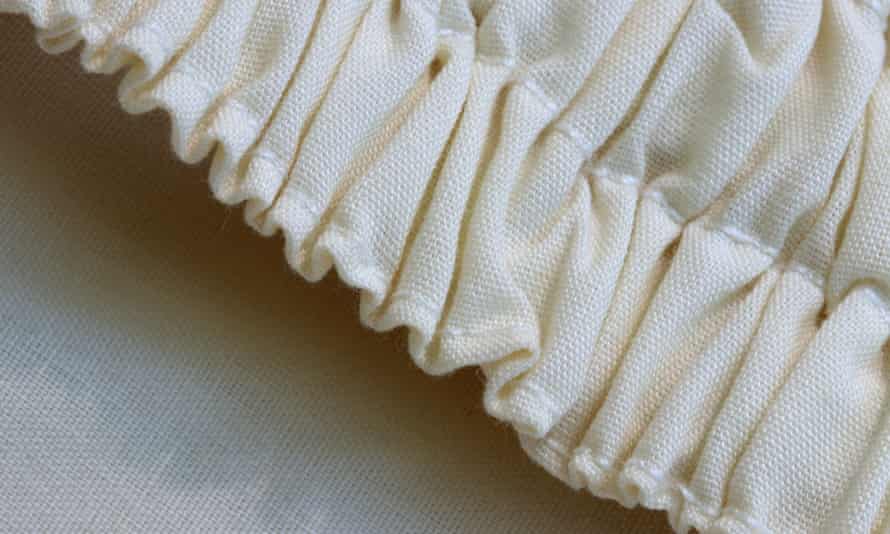
Images and Article from www.theguardian.com.
Any mention of elastic reminds me of being a child. The snap of a rubber band sling-shot across a classroom. Playing dress-ups in tutus with white elastic running inside the waistband. The wide strap across a pair of jiffies.
As an adult, I only ever notice elastic when it has stopped working and the slack material left behind is starting to annoy me.
Most elastics are made of natural or synthetic rubber that have been mixed with other fibres. Imagine a very, very thin rubber band that has been woven with cotton or polyester yarn.
The key feature of elastic is its ability to stretch and retract to its original size and shape repeatedly. When elastic is damaged or aged this ability lessens. There are steps that can be taken to prolong the life and stretch of elastic, but sometimes it will need to be replaced.
This week we got some expert advice on both prevention and the cure.
Don’t over stretch
Carolina Quintero Rodriguez, a fashion lecturer at RMIT University says, “when elastic fabrics are elongated beyond their stretchability or over an extended period of time, the fibres can break or lose the capability of returning to their original shape”. The force, frequency and size of the extension will also influence how long the elastic lasts.
“It is important to reduce the stress of the fibre over time” she says, “so selecting the correct garment size is an important consideration when purchasing next-to-skin garments such as underwear, bras and swimwear.”
Turn the heat down
According to Quintero Rodriguez elastic fibres can be damaged by heat “so it is recommended to wash the garments with low temperature”. She suggests washing “the garments by hand or in a delicate/gentle machine cycle to avoid breakage of the fibre”.
If machine washing is unavoidable, place the garments inside a washing bag to further reduce friction and protect the elasticity. Use a gentle detergent and keep elastic away from chemicals like chlorine and bleach, as they will also reduce its lifespan.
Don’t put stretchy garments in the tumble drier for the same reason – the heat will damage the fibres. Instead, hang them up to dry, but be sure to dry anything with elastic or stretch out of sunlight.
Replacing worn-out elastic
Nicole Mallalieu, a fashion lecturer at the Australian College of the Arts, warns that when “elastic goes, it goes”. Depending on the garment, replacing elastic can be easy – or very difficult. If the elastic is encased and “you can move the elastic within the folded over edge of the fabric” – like an elasticated waist band on a pair of pants or skirt – replacing it is relatively straightforward.
She says to unpick a bit of the casing and pull the old elastic out. It may require a small snip with scissors. Then take your new elastic, thread it through the end of a hair clip or safety pin and feed the clip or pin back through the casing. Do this by pushing the pin along so the fabric gathers up around it, hold the pin while you pull the fabric back over the new elastic. Repeat until the pin emerges around the other side, then knot or stitch the elastic ends together and use a few stitches to close up the hole.
If the elastic has been stitched or over locked into the waistband, Mallalieu says “it can be trickier to change it”.
If you are confident with a sewing machine and very patient, she says you can unpick it and sew on new elastic. Keep in mind that the elastic will stretch as you stitch it on, so cut it slightly shorter than you need, pin it in place with the desired tension and hold the fabric taught as you feed it through the sewing machine.
If unpicking seems too tedious, she suggests seeing it as an opportunity to refashion the garment by cutting the whole section off and sewing on something different like a wide, stretch band.
If the straps on a bra or singlet have lost their elasticity, they can be replaced. Mallalieu says you can buy “bra elastic at haberdashery shops and quickly swap those out”. If you’re worried about not doing a good job, it might be worth taking the pieces to a tailor who can do a more polished repair.

Stretch fabrics
Mallalieu says once the elastic goes in stretchy garments like swimwear and underwear, or anything with ribbing, there isn’t much you can do.
But if just part of the garment – like the cuffs of a hoodie – have become loose they can be replaced as long as you’re handy with a sewing machine. Remove the stretched out ribbing with scissors or an un-picker, fold the new fabric to form a loop that mimics the old one, and use a sewing machine to attach it.
She says to look for similar fabric it at your local haberdashery, or pick a contrasting colour that will compliment the piece. “If you can’t match the fabric,” she says, “see it is an opportunity … to refashion the garment … you could put a ruffle on the end or some wild fringing”.
Mallalieu points out that by the time the elastic has worn out, the rest of the garment is usually looking pretty tatty anyhow, so it might be time to relegate it to cleaning or gardening attire.
Article shared from www.theguardian.com



